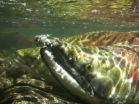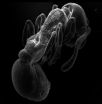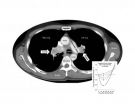(Press-News.org) For sockeye salmon coming home after years spent at sea, a magnetic map is apparently responsible for their remarkable sense of direction. That's according to an analysis of data collected over 56 years and reported online on February 7 in Current Biology, a Cell Press publication.
"To find their way back home across thousands of kilometers of ocean, salmon imprint on the magnetic field that exists where they first enter the sea as juveniles," said Nathan Putman of Oregon State University. "Upon reaching maturity, they seek the coastal location with the same magnetic field."
Scientists had suspected that animals including fish, sea turtles, and seals might imprint on magnetic fields and use their "sixth sense" as a kind of internal GPS system. But actually asking and answering the question has been exceedingly hard to do.
In the new study, Putman and his colleagues looked to sockeye salmon from British Columbia's Fraser River. Those fish leave the river for the sea just like any other Pacific salmon, Putman said. But there's a hitch.
"When they attempt to return, they are confronted with a giant obstacle: Vancouver
Island is blocking direct access to their river!" he said. "So the fish must make a choice: Do they use the northern inlet or the southern inlet in their detour?"
If the fish really do follow magnetic fields, then their choice should vary in predictable ways over the years, the researchers reasoned. That's because of something known as geomagnetic field drift. In other words, the Earth's magnetic field isn't constant; it changes gradually over time based on the chaotic movement of the Earth's liquid outer core.
And that means that fish should show a greater preference in a given year for the inlet that most closely matches the magnetic value of the Fraser River when they left it two years before. Careful comparison by the researchers of fisheries data collected since the 1950s with a model predicting the shifting magnetic field shows exactly that pattern.
The discovery may have practical application for both wild and farmed salmon.
"If you want to predict the distribution of salmon, then having information on their mechanisms of navigation is really important," Putman said, and any distortion to the magnetic field may be a problem.
"The Earth's magnetic field is quite weak compared to the magnetic fields that humans can produce," Putman added. "If, for instance, hatchery fish are incubated in conditions with lots of electrical wires and iron pipes around that distort the magnetic field, then it is conceivable that they might be worse at navigating than their wild counterparts."
That, together with tiny magnetic wires used to tag hatchery salmon, might explain the high stray rates observed in hatchery-raised fish.
INFORMATION:
Current Biology, Putman et al.: "Evidence for geomagnetic imprinting as a homing mechanism in Pacific salmon."
Magnetic map guides salmon home
2013-02-07
ELSE PRESS RELEASES FROM THIS DATE:
For ant pupae, status means being heard
2013-02-07
AUDIO:
This is a recording of ant pupa sound.
Click here for more information.
For young ants at the pupal stage of life—caught between larva and adulthood—status is all about being heard. The findings, reported online on February 7 in Current Biology, a Cell Press publication, add to evidence that ants can communicate abstract information through sound in addition to chemical cues.
"One of the truly fascinating characteristics of social insects is their power of self-organization, ...
Researchers identify potential target for age-related cognitive decline
2013-02-07
As the elderly age, their ability to concentrate, reason, and recall facts tends to decline in part because their brains generate fewer new neurons than they did when they were younger. Now, researchers reporting in the February 7th issue of the Cell Press journal Cell Stem Cell have discovered a molecule that accumulates with age and inhibits the formation of new neurons. The finding might help scientists design therapies to prevent age-related cognitive decline.
The investigators identified the molecule, called Dickkopf-1 or Dkk1, in the brains of aged mice. By blocking ...
Reassuring evidence: Anticancer drug does not accelerate tumor growth after treatment ends
2013-02-07
Studies in animals have raised concerns that tumors may grow faster after the anticancer drug sunitinib is discontinued. But oncologists and physicists who collaborated to analyze data from the largest study of patients with kidney cancer convincingly demonstrate that such tumor acceleration does not occur in humans. The findings, publishing online on February 7th in the Cell Press journal Cell Reports, suggest that sunitinib does not cause lingering risks for patients after their treatment ends.
"We were able to demonstrate that this applied across all patients and that ...
Hopkins researchers uncover key to antidepressant response
2013-02-07
Through a series of investigations in mice and humans, Johns Hopkins researchers have identified a protein that appears to be the target of both antidepressant drugs and electroconvulsive therapy. Results of their experiments explain how these therapies likely work to relieve depression by stimulating stem cells in the brain to grow and mature. In addition, the researchers say, these experiments raise the possibility of predicting individual people's response to depression therapy, and fine-tuning treatment accordingly. Reports on separate aspects of the research were published ...
Treatment with clot-busting drug yields better results after stroke than supportive therapy alone
2013-02-07
In an update to previous research, Johns Hopkins neurologists say minimally invasive delivery of the drug tPA directly into potentially lethal blood clots in the brain helped more patients function independently a year after suffering an intracerebral hemorrhage (ICH), a deadly and debilitating form of stroke. Rates of functional recovery with the active tPA treatment far surpassed those achieved with standard "supportive" therapy that essentially gives clots a chance to shrink on their own.
In the current Johns Hopkins-led study, ICH patients who randomly received the ...
Clot-retrieval devices failed to improve stroke-related disability
2013-02-07
A stroke survivor's chances of living independently after 90 days are not improved by the use of devices inserted into the artery to dissolve or remove a stroke-causing clot shortly after the onset of symptoms, according to a randomized controlled trial involving 656 patients.
The study, funded by the National Institute of Neurological Disorders and Stroke (NINDS), part of the National Institutes of Health, compared the intra-arterial device-based approach plus the current standard of intravenous (IV) tissue plasminogen activator (t-PA), a clot-busting drug with IV t-PA ...
In the brain, broken down 'motors' cause anxiety
2013-02-07
VIDEO:
This video (S3 in the paper) shows the transport defect of the serotonin receptor in a KIF13A knock out neuron compared with a wild type neuron.
Click here for more information.
When motors break down, getting where you want to go becomes a struggle. Problems arise in much the same way for critical brain receptors when the molecular motors they depend on fail to operate. Now, researchers reporting in Cell Reports, a Cell Press publication, on February 7, have shown ...
Salmon may use magnetic field as a navigational aid
2013-02-07
CORVALLIS, Ore. – The mystery of how salmon navigate across thousands of miles of open ocean to locate their river of origin before journeying upstream to spawn has intrigued biologists for decades, and now a new study may offer a clue to the fishes' homing strategy.
In the study, scientists examined 56 years of fisheries data documenting the return of sockeye salmon to the Fraser River in British Columbia – and the route they chose around Vancouver Island showed a correlation with changes in the intensity of the geomagnetic field.
Results of the study, which was supported ...
Immune systems of healthy adults 'remember' germs to which they've never been exposed
2013-02-07
STANFORD, Calif. — It's established dogma that the immune system develops a "memory" of a microbial pathogen, with a correspondingly enhanced readiness to combat that microbe, only upon exposure to it — or to its components though a vaccine. But a discovery by Stanford University School of Medicine researchers casts doubt on that dogma.
In a path-breaking study to be published online Feb. 7 in Immunity, the investigators found that over the course of our lives, CD4 cells — key players circulating in blood and lymph whose ability to kick-start the immune response to viral, ...
Cells forged from human skin show promise in treating MS, myelin disorders
2013-02-07
A study out today in the journal Cell Stem Cell shows that human brain cells created by reprogramming skin cells are highly effective in treating myelin disorders, a family of diseases that includes multiple sclerosis and rare childhood disorders called pediatric leukodystrophies.
The study is the first successful attempt to employ human induced pluripotent stem cells (hiPSC) to produce a population of cells that are critical to neural signaling in the brain. In this instance, the researchers utilized cells crafted from human skin and transplanted them into animal models ...



